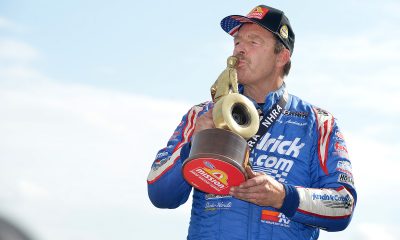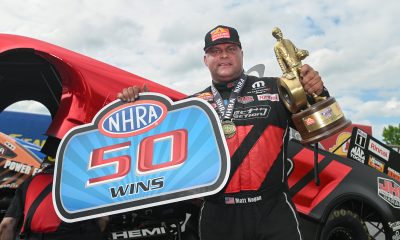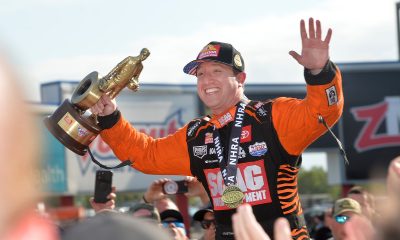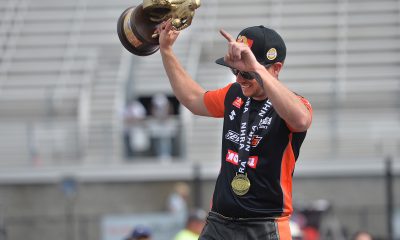
(Photo: Steve Johnson Racing)
In this edition of First Seasons, where The Podium Finish discusses a past or present motorsports driver’s rookie years of racing, we catch up with current NHRA Pro Stock Motorcycle rider Steve Johnson to talk about his early days of racing a motorcycle.
During the interview, Johnson talks about how he got started racing, the challenges of owning a race team, what interested him in racing bikes in the first place, making his debut at Englishtown in 1987, going through a rough patch from 1990 through 1994 before breaking out in 1995, and so much more.
Briar Starr: You made your Pro Stock Motorcycle debut back in 1987 at Englishtown at the age of 26-years-old. How did you go about getting your first bike to compete and if you can remember, what type of bike did you have? Was it a dream come true for you to race in NHRA during that time?
Steve Johnson: It was a transitional period during the Pro Stock Motorcycle days, as the motorcycles had motorcycle tires at the time, but the transition was, that the riders began using car tires on their Pro Stock Bikes. That’s what we did. We had a stock Kawasaki chassis that we raked and we put a double club swingarm on it. We just bolted this stuff on and you could put car tires on the bike.
We had this teeny tiny replica Kawasaki Z1 gas tank that was fiberglass with a one-gallon cell inside of it. It also included an aluminum side cover and a tail section that was basically, it was a throw rug that you tried to cover a 747 with. In addition to that, we were street racers who were tired of the dangers of street racing and wanted to race in the big leagues.
We built a wooden crate and we airfreighted the bike to the racetrack. Back then, we pitted on a gravel area and a big tractor-trailer pulled up, the track brought a forklift, and they forklifted the crate out of an 18-wheeler. Eventually, they were set over by an abandoned flatbed trailer. When we unloaded the bike, we brought out our extension cords to plug into other people’s stuff, and it was really low rent.
We had a tiny toolbox and I don’t think we had a starter cart for the bike. I remember Terry Vance (owner of Vance and Hines, former rider) coming over to look at it and he said ‘If you need anything, just please let us know.’ When we came back the next morning, they had drawn Sharpie tires over our crate like it was our wooden trailer. It was a different time period racing Pro Stock Bikes.
Starr: At the age of 26, it was relatively unheard of for someone to make their debut back then in NHRA. Did you feel like you were ready to race in NHRA when Englishtown came along?
Johnson: I never thought my career would last this long as it did, but it was everything I wanted to do. I tried doing street racing and other sanctioning bodies, but nothing came close to competing in the NHRA. It was the Ferrari of racing.
Starr: Coming into NHRA for the first time, there’s a lot of uncertainty about whether you’ll be around for a long time. As a rookie, what kind of expectations did you have as an owner and as a driver and was it hard to manage those expectations? You wanted to win races and championships, but realistically, what were the general expectations at first, and did those expectations change as the years went on?
Johnson: We were pretty good street racers at the time, but we didn’t know what it took to win in the NHRA. We only knew what we knew. We just thought you showed up, cut good lights, and win. My expectations were high coming in and it took years for me to figure out how to win the races. Even right now in my later years, I’m still trying to figure out how to get victories.
Starr: Your first start came at Englishtown where you qualified 16th and had your first-round win over Rick Gero before losing to Frank Martorelli. What were the weeks like leading up to your initial debut? Were you anxious or nervous, or were you ready to go after having a few runs during qualifying?
Johnson: I think the weeks before was all about getting everything ready. Back then, it was all about getting airplane flights, hotels, trying to find cheap this and that, and how we were going to eat. At the time, Harry Gunusen, Rusty Gill, Eddie Alvarez, and Allen Johnson all helped with the program.
I was at Harry Gunusen’s shop putting the engine together. It was a thrash trying to get the bike done because it wasn’t a full-time job. When we had time, we worked on it. We were waiting on parts because we were waiting on money. However, we never complained about the money. We always wished, but we never threw in the towel. We just figured out how to make it happen.
Much like Gaige Herrera, when he showed up to compete a couple of years ago, he had help from Garry Stoffer and Greg Underdahl. Gunusen helped him too. That’s what’s so cool about our sport. When someone new shows up, it just seems people are rewarded with support. People are sending $50 or $100 to help. It was a big deal.
That was the whole preparation, getting the engine ready, and starting the bike. Back then, everything was low rent, but we were as happy as we could be.
Starr: What was it like making your first pass that weekend? Did making rounds on the bike ever sink in for you?
Johnson: When we realized we were there and eating dinner that night, you would’ve thought we were wrestlers because we walked into the restaurant with our chests hanging out. I remember talking to Connie Kalitta (owner of Kalitta Motorsports) and said, ‘Hey man, I got a bike here. Do you want to bring it to the next race?’
He looked at me and thought I was a guy who was from the internet who was going to send him a million dollars.
Starr: Later on in that year, you made some starts at historic tracks like the U.S. Nationals and the finals in Pomona. As a rookie, what was going through your mind when you were showing up to these tracks for the first time? Were the tracks intimidating at all?
Johnson: It was always something. At Indy, I just remember not having parts and brackets. Team Torch was there and they welded a bunch of stuff for us. We were building brackets to hang the bodywork on at Indy. We knew it was the biggest race and we just wanted to be a part of it. We didn’t realize being ready was important. We just wanted to be there.

(Photo: Steve Johnson Racing)
Starr: For the 1987 season, you had four first-round wins and four second-round losses. Was there ever a learning curve in racing a Pro Stock Bike, especially knowing what was to come in the ‘88 and ‘90 seasons? If so, what challenge were you facing and did you ever get comfortable or more experienced with the more reps you continued to gain?
Johnson: Back in the early days, we had computers, but not so many monitors as we do now. There was no download into a computer. The information was downloaded into a printer and the printer printed out the information. The paper was like a toilet paper roll and it was just this one long roll of paper. You would look at the little dots on the paper and you would determine if it was spinning or bogging, and determine where your shift points were.
You would have to analyze all of these things. For somebody who didn’t have a computer, Dave Schultz (former motorcycle rider) was good at that stuff. He created the computer to adapt to the motorcycle. We would always end up asking other people for advice on that. When we would make a change on the bike, we thought we were going to light up the world, but instead, we went slower or maybe a little faster.
Starr: Following the first three seasons as a rider, you faced some challenging years before what appeared to be a breakout season in 1995 with three runner-up finishes. What kept you going during those tough years, and was there ever a time you thought about giving up and doing a different career path?
Johnson: I thought it (racing) was never tough. Every time I worked on the bike, I was having fun. It was a blast. People would come and help, and they would give me advice. I thought I was pretty smart back then and then I would justify myself losing by not having a big trailer or all the engines.
I think when I justified it, I wasn’t being mean to anyone else. I justified it to myself because I was having so much fun. How can you quit something that you’re having so much fun doing? When people lose, they think they’re not having fun. Well, when I was just starting up, I was having so much fun being a part of the Pro Stock Bike class.

(Photo: Steve Johnson Racing)
Starr: As you continue to reflect on your early career in Pro Stock Bikes, were you satisfied with what you were able to do with what you had as a rider or do you think you could have done more? And if so, what in your mind do you think you could have accomplished?
Johnson: I knew very little back then, but my reaction times were always good on the Christmas tree. It was just a different deal back then because you didn’t pop the clutch. You slid the clutch out. There were areas I did good and it just created the continued desire to come back.
To answer your question, I was always happy. I don’t think satisfied is the word to use. Racing wasn’t a career back then. I didn’t realize racing was going to be what it was. I was happy to be a part of it. I was such a socializer too. We would come back, lean the bike back in the pits, put gas in it and I would go on over to the Winston suite.
I remember they would come by for an interview and ask me the difference between the two lanes, and I wouldn’t know anything about the lanes but I can tell you where the shrimp cocktail is.
Starr: Eventually, you obtained your first win at St. Louis in 2004 over Craig Treble. What did that victory mean to you after all the early challenges?
Johnson: I just remember leading up to that race, my mom would tell me, ‘The grocery store is hiring box boys and they make good money.’ People were always telling me about other jobs and I was just convinced I was going to make a million-dollar sponsorship. I remember her telling me that every year or so, especially at Thanksgiving or Christmas. She would ask ‘When am I going to start saving my money and start doing other things?’
After I won that race in 2004, I just thought, I knew exactly what to do now, even though I got lucky.
Starr: So far in your motorcycle career, you have 12 career victories with 20 runner-up finishes and seven No. 1 qualifiers and have come close to the championship numerous times. What would you say is your favorite trophy in your career so far?
Johnson: My favorite trophy is Indy, the year we got the trophy the following week (2005). (NHRA) said we didn’t win and the electronic beam didn’t see it, even though we were the first motorcycle across the finish line. The TV cameras saw it, but at first, they awarded the trophy to Matt Smith before giving the trophy to us a week later.
Just the fact it was the most controversial win in the history of our sport and the fact it was at the biggest race of our sport, the U.S. Nationals. That trophy has the biggest story and biggest prize.
Starr: Some racers have a memorabilia collection and some don’t. Are you a driver that collects your own merchandise and if so, what in your collection reminds you about your rookie season(s)?
Johnson: I do collect a little bit of stuff. I have the bike that we won the 2008 U.S. Nationals with, that’s our Snap-On bike. I got a piston from one of our first engines and a lot of broken parts. There’s a glass that we had gotten from Applebee’s where we were at when we first went racing in ’87. Then uniforms, t-shirts, parts, notes, cards, etc.
When I was done with an NHRA race back then, I would do a press release and send a press release to everyone at the NHRA. There were no computers, so I had to mail it. I would go to the grocery store with a camera and I would develop all the pictures, and I picked the pictures that I thought would tell the best story. Eventually, I chose between 50 to 75 photos printed and then I would put a picture, and my press release in an envelope to send out to everyone in the NHRA. That’s how we did it back in the day.
Starr: What is one memory or lesson you learned in your rookie season that helped you later on in your career or something that you still apply today as a rider?
Johnson: There’s not a hardcore rule about buying plane tickets. You buy them when they are the cheapest. Also, if you got a spark plug or $10,000, and you tell that person ‘thank you’ right away, and you make them feel like you were sincere with a genuine reaction such as a handshake or card, I learned that early on from John Asher. He was my mentor for the business side of the sport.
He always taught me to do a report. Create a document on everything that you do and that was valuable in the board room. Just making sure the sincerity of the ‘thank you’ and creating the document would be the two things I learned.
Starr: Wrapping this interview up – It’s hard to believe your first start came 37 years ago. However, if time travel was available, what would a 63-year-old Steve Johnson tell a 26-year-old Steve Johnson? Is there anything you would do differently?
Johnson: Your sponsors can become friends, but your friends and the memories are really what you have to grab onto because you can’t always win. What I mean by that is, your sponsors can become your friends, however, the friends and memories you create at the races will be more important than anything that you have.
Editor’s Notes
Fans wanting to keep up with Steve Johnson can follow him on X and Instagram, as well as Facebook. You can also check out his website here.
Special thanks to Emma Tolbert of Steve Johnson Racing for coordinating and assisting with the interview and many thanks to Steve Johnson for taking the time out of his busy schedule to conduct the interview.












